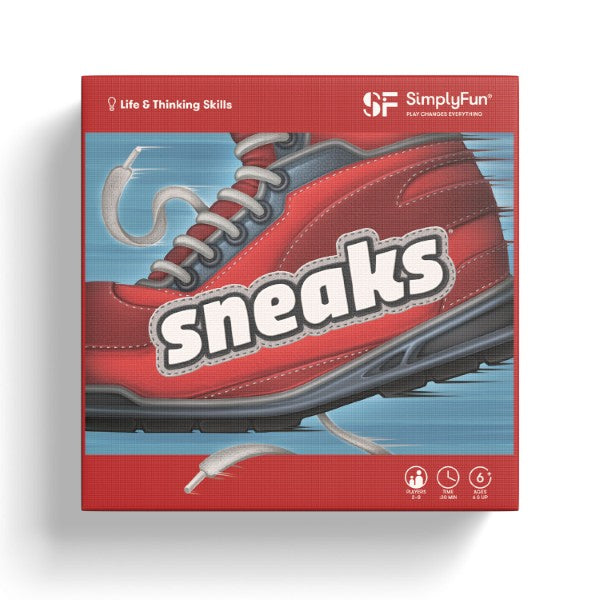
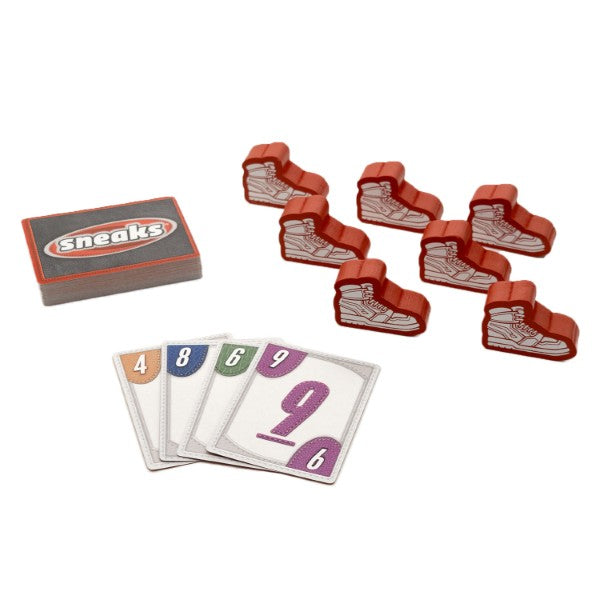
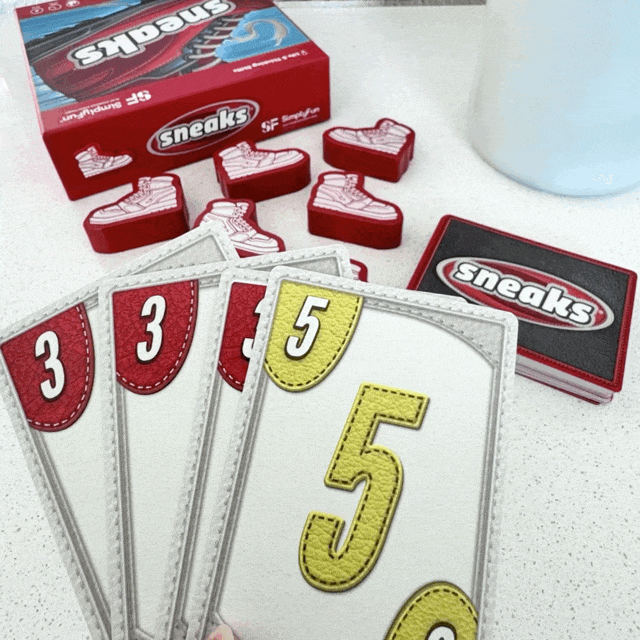
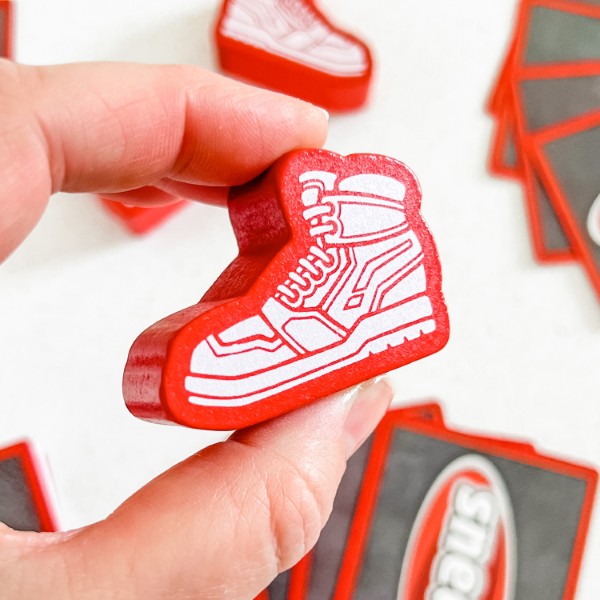
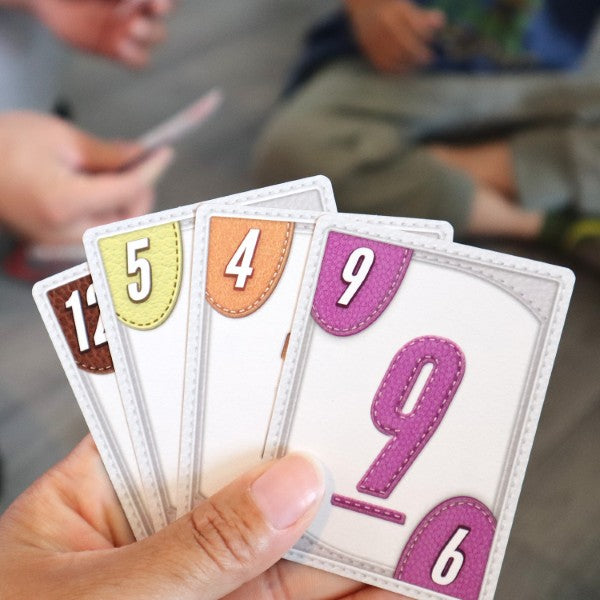
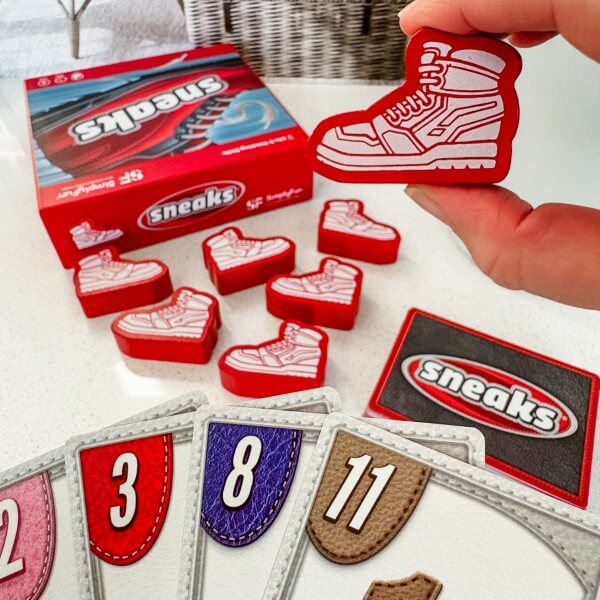
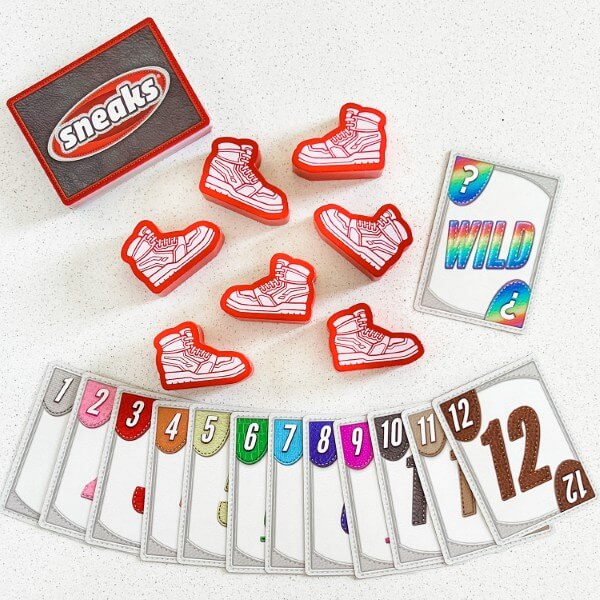

Collapsible content
Our variation of the fast-paced card game “Spoons” that has everyone sneaking around.
You can play Sneaks with 2-8 players, ages 6 and up!
Sneaks is great for working on Decision Making Skills, as players choose which cards to keep and which to pass along based on what they have in their hands and what they may have previously passed on.
Sneaks also helps develop Quick Thinking as this is a speed game, so players need to think fast when passing their cards and be even quicker to grab a sneaker pawn once the first one is taken.
To set up the game, place the sneaker pawns in the center of the play area where everyone can reach them. There should be one less sneaker than there are total players.
Shuffle the deck and deal each player four cards. Place the remaining cards in a draw pile next to the dealer.
To determine who is the first dealer, each player draws a card from the deck. The player with the lowest number is the starting dealer.
If there is a tie for the lowest, draw again. Dealing duties move from player to player each round in a clockwise direction.
The object of Sneaks is to collect four cards with the same number value and grab a sneaker pawn from the center of the play area. The player who is not fast enough to grab a sneaker is eliminated from the game. The last player with a sneaker wins the game!
The game is played in rounds. The dealer starts the round by drawing one card from the draw pile. They then choose a card from their hand and pass it facedown to the player on their left. As this happens, each player picks up the card passed from the player on their right and then chooses a card from their hand to pass to the player on their left.
Players decide which one among the five cards in their hand to discard next and repeat the process. Players are not allowed to pick up a new card from the player on their right until they have discarded a card to their left.
At NO point can a player have more than five cards in their hand at any one time.
The player to the right of the dealer places their unwanted cards facedown to create a discard pile. Play continues until a player collects four cards with the same number value (four of a kind) in their hand.
There are also two wild cards. These wild cards can be used as any number to help collect four of a kind.
If a player collects three of a kind plus a wild card, that equals four of a kind and the player may grab a sneaker.
When a player collects four of a kind, they do not say anything. Instead, they grab a sneaker from the center of the play area. The idea is to be as “sneaky” as possible and to try and remove a sneaker so that the other players do not immediately notice. As soon as a player has taken a sneaker, all other players quickly try to grab one.
Other players do not need to have four of a kind in their hands to grab a sneaker. Only the first player to grab a sneaker must have and show the four of a kind in their hand. The player that is then left without a sneaker is eliminated from the game.
If the first player to grab a sneaker does not have four of a kind, it is a false grab, and that player is eliminated.
The next round starts. Players return the sneaker pawns and remove one of the pawns so there is always one less pawn than there are players. Pass all the cards to the next player on the left—they are the next dealer. Shuffle the deck and play again.
If no one collects four of a kind before the draw pile runs out, the dealer then uses the discard pile to draw from.
The game ends when there are only two players and one sneaker left. The first player to grab that sneaker wins the game!
Get sneaky with this fast-paced card game and see how many sneakers you can grab when you play Simply Fun’s Sneaks.


Head Start*
Language
- Listening & Speaking
- Shows progress in understanding and following simple and multiple-step directions.
- For non-English-speaking children, progresses in listening to and understanding English.
- Develops increasing abilities to understand and use language to communicate information, experiences, ideas, feelings, opinions, needs, questions and for other varied purposes.
Math
- Numeracy & Operations
- Demonstrates increasing interest and awareness of numbers and counting as a means for solving problems and determining quantity.
Core Standard*: Math
Math
- Counting and Cardinality
- Know number names and the count sequence. Grade Levels K


Explore
What Does Child Do To Use Skill In The Game?
During game, players must keep aware of sneaker pile and whether another player has taken a sneaker.
How Parents Can Assist Learning
No special parent support required.
Learning Implications and Educator Support
Children need to attend to two different issues, i.e. split focus and shift attention. This is important cognitive skill for prioritizing information and attending to complex systems.
Determine
What Does Child Do To Use Skill In The Game?
Players must determine what cards they have and do they continue to support reaching their 4-of-a-kind goal. Players must also determine when to grab a sneaker.
How Parents Can Assist Learning
Children may need support to maintain concentration on two different subjects, i.e. their cards and the sneaker pile. Help children by reminding them throughout the game to also keep checking out the sneaker pile.
Learning Implications and Educator Support
Being able to simultaneously attend to multiple events or subject-matters is an important cognitive skill for high level executive functioning and creative problem-solving.
Children may need support to maintain concentration on two different subjects, i.e. their cards and the sneaker pile. Help children by reminding them throughout the game to also keep checking out the sneaker pile.
Compare
What Does Child Do To Use Skill In The Game?
Players compare the card they are handed with those they have, evaluating if they have matches, potential matches and which they might pass to the next player.
How Parents Can Assist Learning
No special parent support required.
Learning Implications and Educator Support
Children playing Sneaks are likely to be proficient at matching and classifying. Encourage children to organize cards numerically to help make comparison easier.
Remember
What Does Child Do To Use Skill In The Game?
Players will be more successful if they can remember the card numbers they passed to the left.
How Parents Can Assist Learning
No special parent support required.
Learning Implications and Educator Support
No special educator support required.
Plan
What Does Child Do To Use Skill In The Game?
Players hold and discard cards based on a plan to gather 4-of-a-kind. This planning is helpful, but limited because there is a high degree of luck as to which cards the player receives.
How Parents Can Assist Learning
Encourage children to not change their plan once they have 3-of-a-kind. Keep holding out for that last card to make a set of four.
Learning Implications and Educator Support
Sneaks involves a little strategic thinking. Players need to consider the probability of a card they need being passed to them. Reinforce that children should pay close attention to the cards that have been handed to them and the one's they have passed along. Encourage children to not change their plan once they have 3-of-a-kind. Keep holding out for that last card to make a set of four.
Solve
What Does Child Do To Use Skill In The Game?
Players solve the game by choosing which cards to pass and, hopefully, obtain 4-of-a-kind before the other players. Players can also solve the game by grabbing sneakers faster than the other players.
How Parents Can Assist Learning
No special parent support required.
Learning Implications and Educator Support
No special educator support required.
Demonstrate
What Does Child Do To Use Skill In The Game?
A Player who grabs a sneaker first must show that they have 4-of-a-kind.
How Parents Can Assist Learning
No special parent support required.
Learning Implications and Educator Support
No special educator support required.
*Data compiled from CCSSI ELA Standards, WA Science Standards, and Washington Social Studies Standards


Cognitive
Suggestions for How to Modify Play Experience
Modify the game so the goal is to get four of the same color or one of each color. This is easier as there are twelve of each color, giving children more opportunities to get four of a kind. Also, children with cognitive delays may are able to match colors more easily than numbers.
Change the rules, so children with cognitive delays only need to get three of a kind. This will be easier and will provide a reward for play earlier in the game.
Communication
Suggestions for How to Modify Play Experience
Play the game GO FISH with the cards from the game (remove wild cards). Prior to starting the game, all players agree whether to get sets of at least 3 of one color, number, or runs for three-in-a-row. You could also let each child choose which to go for when they get their hand. Children each are dealt five cards. The rest of the cards are placed face down on the table, with one card turn up in the discard pile. When it is a player's turn, s/he decides whether to ask for a specific needed card from another player, to draw a card, or to pick up the discarded card. When a player has 3 cards of what they are looking for, they show them to all the players and lay them down. The game ends when all the cards in the draw pile are gone or when a player has no more cards in his or her hand. The player with the most sets of 3 at the end of the game wins.
Play a concentration type game as a cooperative effort. Place numbers 1-12 of 2 colors face down randomly on the table. Players take turns turning over two cards at a time. The goal is to find a sequence of numbers from 1-12. As the players look for the next number in the sequence, many cards will be revealed. Children communicate with each other about where they think the next number in the sequence will be.
Sensorimotor
Suggestions for How to Modify Play Experience
Children will practice fine motor manipulation when passing cards and placing new cards in their hands. If children have difficulty holding and manipulating several cards, make a simple card holder from construction paper. Fold a piece of 8 1/2 X 11 construction paper length wise to make a tent. Fold a 1/2 inch lip outward on one side of the tent. This is the ledge to support the cards.
Children who have motor concerns may move slowly or not have accurate reach. For these children, modify the game so that the person who gets a set and takes a sneaker shouts, "Close your eyes!" Everyone then closes their eyes and tries to grab for a sneaker. The person who got the set watches and if anyone doesn't close their eyes, that person must give up their sneaker to the person who didn't get one. This variation levels the playing field, making it a little more challenging for all players to get a sneaker.
Social Emotional/Behavioral
Suggestions for How to Modify Play Experience
Children who are very shy may be slow to get the sneakers. For these children, modify the game so that the person who gets a set and takes a sneaker shouts, "Close your eyes!" Everyone then closes their eyes and tries to grab for a sneaker. The person who got the set watches and if anyone doesn't close their eyes, that person must give up their sneaker to the person who didn't get one.
Vision
Suggestions for How to Modify Play Experience
Use a card holder, if needed. This will allow children with low vision to see the larger number in the middle of the card. To make a card holder, fold a piece of 8 1/2 X 11 construction paper length wise to make a tent. Fold a 1/2 inch lip outward on one side of the tent. This is the ledge to support the cards.
Use a black marker to clarify the number 7 or draw a dark line horizontally through the middle. Without enhancement the 7 may look like a 1 to children with low vision.
Hearing
Suggestions for How to Modify Play Experience
No modifications needed.
*Data compiled from CCSSI ELA Standards, WA Science Standards, and Washington Social Studies Standards


Autism Strengths & Interests
Short Summary of Strengths & Interests
- Has good visual matching skills.
- Can notice actions of others.
- Likes card games.
Is good at matching visual items
Is This Game Appropriate? Yes
Description
Sneaks is a game requiring players to match the numbers on cards in their hand to get four of one kind. Thus, it is a good match for children who are good at matching numbers or symbols. In addition, colors on the cards assist the players in making matches.
Has a good memory for sensory details, including visual, touch, taste and smell
This game is not appropriate
Has a good memory for words, phrases and dialouge
This game is not appropriate
Has a good memory for pictures, numbers and patterns
This game is not appropriate
Likes to put things in order or a sequence
Is This Game Appropriate? Yes
Description
The goal of Sneaks is to be the first person to get four of one kind. For children who enjoy grouping like things together will build on visual mapping skills playing Sneaks
Learns through visualizing or "replaying" actions in their mind
This game is not appropriate
Likes activities with rules, such as math and phonics
This game is not appropriate
Is very concrete and literal
Is This Game Appropriate? Yes
Description
Even though Sneaks involves numbers, it is a very literal game. Players are matching the numbers, not doing math. Therefore Sneaks appeals to children who enjoy literal activities and can also be a good introduction to numbers for children who are just learning early math concepts.
Learns in small "chunks" (for example, phone numbers are 3 chunks of number xxx-xxx-xxxx that are combined together)
This game is not appropriate
Is good at nonverbal reasoning and logic
Is This Game Appropriate? Yes
Description
Some children are good at logic and reasoning, but do not like to discuss or verbalize their thinking. In Sneaks, children use their logic to determine what card to pass to the player on the left while trying to be the first to create four of one kind. However, they do not need to discuss and talk about their reasoning and strategy.
Likes spatial problem solving
This game is not appropriate
Can read well with good vocabulary, though may not fully comprehend content
This game is not appropriate
Likes to use and has good fine motor skill
Is This Game Appropriate? Yes
Description
For children who have good dexterity, especially those who enjoy playing with cards, will be able to emphasize dexterity playing Sneaks.Description VERBIAGE GOES HERE
Likes established routines or set ways of doing things
Is This Game Appropriate? Yes
Description
Sneaks follows the same routine every game. Pick up card on your right and discard to person on your left. It is a very rhythmic, set way of playing and, therefore, may appeal to children who prefer predictable activities.
Likes to use and has good musical abilities
This game is not appropriate
Likes to use and has good drawing skills
This game is not appropriate
Autism Special Considerations
Appears to ignore other's communication and/or has difficulty giving eye contact to a communication partner
Is This Game Appropriate for Child with Characteristic? Yes
Can Child with Characteristic Play Game w/o Modification? Yes
Strategies for Developing Compensatory Skills:
Sit or stand at an angle to the child, so direct eye contact is not needed.
Look at the game instead of each other.
Use unusual or exaggerated inflection to begin a communication about the round. This attracts the child's attention.
Has difficulty understanding complex verbal directions
Is This Game Appropriate for Child with Characteristic? Yes
Can Child with Characteristic Play Game w/o Modification? Yes
Strategies for Developing Compensatory Skills:
Combine short verbal instructions with visual and physical examples of each step.
Check for comprehension by asking the child to show you what to do next.
Let children read the directions as they are explained. Visualizing the words is often a stronger learning method for children with autism.
Practice several hands before starting the game.
Uses vocabulary inaccurately or demonstrates echolalia (repeating another's speech)
Is This Game Appropriate for Child with Characteristic? Yes
Can Child with Characteristic Play Game w/o Modification? Yes
Strategies for Developing Compensatory Skills:
Respond to immediate echolalia (repeating what was just said) by rephrasing the child's response into a correct format, so the child can hear and repeat that phrase. For example, assume you are playing with a child named Andy and you say, "Your turn," and Andy repeats, "Your turn." You can say, "It's Andy's turn. You say, my turn." This allows the child to hear and repeat the correct response. Eventually, the child will pick up the pattern of response.
Delayed echolalia (repetition of previously heard comments) may have a hidden meaning or association. Look for connection in the phrase used to the current situation. For example, the child says, "After these messages we'll be right back!" Think what the repeated phrase is associated with for the child. Try to interpret what is meant and rephrase it for the child. For example, you might respond by saying, "It sounds like you want a break for a few minutes. Is that what you mean? You can tell me, 'I need a break.'"
Gets stuck repeating a verbal topic or physical actions and/or has difficulty attending to others' actions or topic.
Is This Game Appropriate for Child with Characteristic? Yes
Can Child with Characteristic Play Game w/o Modification? Yes
Strategies for Developing Compensatory Skills:
The game can be played without talking, but if the child talks about an unrelated topic, remind them watch the sneakers to refocus attention. Practice phrases for commenting on others' play actions. For example, you say to Joe (who is playing with you), "Right on! You got a sneaker." Then ask the child, "What did Joe do? "
Remind children about listening and watching others' before making their own comment or action.
Extend the child's action to make a correct response. For example, if the child passes one, but forgets to take one from his right; say, "Look right. There is your card".
Reinforce attention and actions by commenting on what was done correctly. For example, "You saw them take a sneaker and grabbed one! Way to go!
Has difficulty producing speech/communication
Is This Game Appropriate for Child with Characteristic? Yes
Can Child with Characteristic Play Game w/o Modification? Yes
Strategies for Developing Compensatory Skills:
Speech is not needed to play the game.
Has difficulty sequencing multi-step actions and/or doing complex abstract tasks
Is This Game Appropriate for Child with Characteristic? Yes
Can Child with Characteristic Play Game w/o Modification? Yes
Strategies for Developing Compensatory Skills:
Directions and tasks are simple.
Demonstrates difficulty initiating and maintaining social interactions
Is This Game Appropriate for Child with Characteristic? Yes
Can Child with Characteristic Play Game w/o Modification? No
Strategies for Developing Compensatory Skills:
Children who have difficulty paying attention to others' actions may have difficulty noticing others taking sneakers. Unless the child can learn to watch the center of the circle for other's actions, the game may be inappropriate.
Do several practice rounds with players "sneaking" the shoe from the center and reinforce the child's attempts to pay attention. This game may provide good practice for paying attention to others' actions if the child can learn this behavior.
Let the child practice trying to take the shoe without others seeing. You will need to give clues about how to do this.
Acts out or demonstrates avoidance behaviors when frustrated, overwhelmed, or needs more sensory input.
Is This Game Appropriate for Child with Characteristic? Yes
Can Child with Characteristic Play Game w/o Modification? No
Strategies for Developing Compensatory Skills:
Reduce extraneous noise or allow the child to wear head phones or ear plugs if loud sounds cause anxiety.
A weighted vest worn during the game may provide additional pressure input and thus reduce fidgeting due to sensory needs. Pressure can be calming when used for no more than 20 minutes at a time.
Practice a phrase to ask for help and role play situations in the game where it is needed.
Provide techniques for self-calming, such as holding a special toy.
Allow time for movement. For example, a child who needs to move frequently can be given an opportunity to 'celebrate' their turn by running around the table or jumping up and down 10 times.
Has short attention span for non-preferred activities
Is This Game Appropriate for Child with Characteristic? Yes
Can Child with Characteristic Play Game w/o Modification? Yes
Strategies for Developing Compensatory Skills:
Provide a break when needed.
Incorporate a motivating activity as part of the play. For example, each player gets to manipulate a fun 'fidget' toy, such as a stress ball or squeeze toy after a round.
The game moves quickly, so if the child is enjoying it attention span should not be problematic.
Needs sameness or consistent routines and/or has difficulty with transitions from one activity to another
Is This Game Appropriate for Child with Characteristic? Yes
Can Child with Characteristic Play Game w/o Modification? No
Strategies for Developing Compensatory Skills:
Play games at the same time every day, so the child anticipates the game routine.
Change the location of the game, so the child may play in different rooms, at the table, or on the floor. This will build tolerance for variation. Prepare the child ahead time for the introduction of a new game. Talk about aspects that will be motivating for the child, and let her explore the parts of the game before setting out the whole game.
Provide a structure for placement of game pieces that can be the same each time the game is played. For example, have a specific location for where the board goes, the pieces, etc. Provide choices for how the child can be involved in set up or clean up. For example, you might ask, " Do you want to be a dealer or a regular player?"
Use an object cue. Let the child hold an object from the game or activity you want to introduce prior to the transition. For example, if you were intending to play Sneaks you would hand the child a Sneaker from the game and say, "Look here is a sneaker. What game does it go with?"
Has difficulty understanding others' feelings, intentions, and the reasons for others' actions.
Is This Game Appropriate for Child with Characteristic? Yes
Can Child with Characteristic Play Game w/o Modification? No
Strategies for Developing Compensatory Skills:
Some children have difficulty reading others' cues and understanding that their actions indicate what is intended. Children may need to be trained to watch others hands to see what they are going to do.
Ask child to explain their own feelings and intentions,
Ask child to explain why other players did specific actions in the game.
*Data compiled from CCSSI ELA Standards, WA Science Standards, and Washington Social Studies Standards


Extra Ways to Play the Game
The game can be played more easily in several ways. The easiest version would be to get four of the same color or one of each color. The next version would be to get a run of at least four numbers in a row. Try all versions! Then let players choose which version they want to play.
Materials Needed
No additional materials needed.
Developmental Benefits
Matching like items is the easiest mental task. Having to sequence numbers requires that children know what number comes before and/or after a given number. This expansion provides practice in relating numbers to each other.
Extra Ways to Play the Game
Try this as a memory game. Start with 2 colors of all 12 cards for the easiest version. Players have to find a pair of number matches. To increase difficultly, try using numbers 1-8 of three colors. Players need to make a set of 3 for a successful match. The most difficult would be to remember where four numbers of four different colors are located. For this version use numbers 1-6 for all four colors, add more cards as children developed ability to handle increased difficulty.
Materials Needed
No additional materials needed.
Developmental Benefits
The benefit of a memory game is that children increase their visual spatial memory skills. You can play with the cards in a matrix on the table or with cards randomly spread on the table. Each version requires a slightly different type of spatial memory. One focuses more on memory for location, and the other adds an element of directionality for how the cards are placed. Try both versions.
*Data compiled from CCSSI ELA Standards, WA Science Standards, and Washington Social Studies Standards
Game Details
- 50 Sneaks Cards
- 7 Sneakers
- 1 Rules Booklet
- Choosing a selection results in a full page refresh.
- Opens in a new window.










